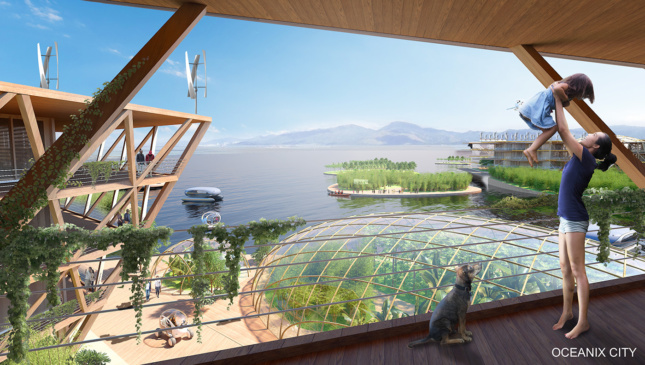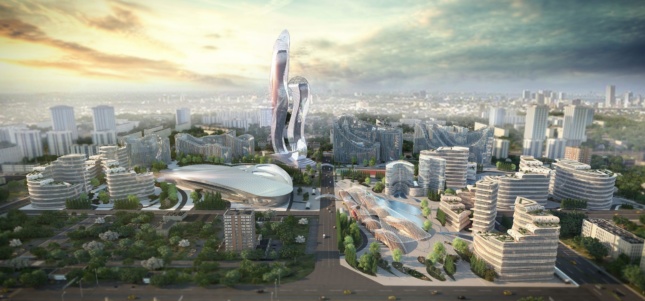If you mingle within the spheres of design and architecture, I’m sure you’ve seen them. They dwell within endlessly scrollable design websites and social media feeds; some even make it to print. Slick renderings of tree-lined balconies and floating cities; design “solutions” involving AI or 3D printing or bitcoin or whatever the new tech buzzword may be; publicity stunts and art projects devoted to “calling attention” to any given issue—these are only a handful of the subgenres that make up a greater force, a phenomenon I call “PR-chitecture.”
I coined the term last month when I published an article on my blog McMansion Hell calling attention to how designers and brands were using the coronavirus pandemic to promote themselves and their increasingly bizarre and ridiculous roster of solutions and public service announcements, effectively capitalizing on a major public health, social, and economic crisis under the cover of “good design.” However, architecture and design have had a PR-chitecture problem for far longer than the span of a few, tense months.

PR-chitecture is, essentially, the architectural equivalent of vaporware: Proposed projects, ideas, and innovations that generate a lot of hype and publicity and yet never materialize (and even when they do materialize, they do so in a muddled-down form). It’s architecture for the click economy, a product of the internet age of short attention spans and a constant, uncritical drive towards the new and shiny. PR-chitecture is the inevitable result of an image-driven, buzzword-laden media atmosphere where big ideas and sumptuous imagery are rewarded time and time again with attention, clicks, and opportunities over the work of up-and-coming or more critical and subversive practitioners.
Its visual language is the computer rendering, and its textual language adopts the self-congratulatory tone of public relations—of savvy corporate rhetoric willing to capitalize on the issue du jour, often conveniently covering up a brand or firm’s unsavory contributions to the conditions from which those issues arise. “We are living in unprecedented times, with issue x and issue y weighing heavily on our horizon, presenting us with an uncertain future,” one blurb will say, while another parrots “the problem of x requires bold and innovative new solutions at the intersections of y and z.” The time for action is always now.
Likewise, the solutions at these intersections of y and z are always surface-level—technocratic at best and tone-deaf at worst. Their authors believe uncritically that design can and will solve all of our problems, from climate change to income inequality. (We’ll solve the novel coronavirus with shipping container hospitals, climate change with floating cities and income inequality with 3D-printed houses.) Conveniently, all of these solutions are salable, generating attention and income—click-based ad revenue or commissions, it’s all the same, really—to those peddling them. It’s a win-win situation: your firm ends up on the front page of Dezeen, plus you end up looking forward-thinking and compassionate to the plight of the unsophisticated masses who could truly benefit from your bold and innovative ideas. Most of the time, you don’t even have to go to the trouble of building anything!
When I think of PR-chitecture, one project, in particular, comes to mind: BIG’s (in cooperation with Oceanix, a floating architecture design solutions company) Oceanix City, a proposed solar-paneled floating city presented to the UN in 2019 as a possible solution to sea-level rise posed by the climate crisis.
Oceanix City has all the markings of PR-chitecture; a fantastical project put out by one of architecture’s media darlings that will almost certainly never be constructed, whose development is underwritten by obscure NGOs and start-ups with stakes in the game, whose visual language exists solely in the form of sexy, video-game-esque computer renderings. BIG’s namesake Bjarke Ingels described his proposed city in the usual architecture-speak: “We’ve based it on this modular idea of a hexagonal island…It has the omni-direction of a circle but it has the modularity and rationality of something manmade.” The article about Oceanix City in Dezeen takes Ingels’s project at face value, with the faux-journalistic aplomb that allows ideas like it to fester. In doing so, the site delivered Ingels his environmentally friendly bona-fides, just months before he was caught red-handed attending business talks with the climate denialist, right-wing Brazilian president Jair Bolsonaro.

One might wonder what the difference is between PR-chitecture like Oceanix City and the classics of 20th-century paper architecture, such as Archigram’s Walking City or the megastructures put forth by the Japanese Metabolists. It’s fair to say that much of PR-chitecture’s worst impulses (namely the allure of top-down, technocratic, large-scale design solutions) have their very origins in the fantastical drawings and technological utopias of the 1960s and ’70s. However, unlike projects like Oceanix City, a good deal of paper architecture’s projects, for better or worse, were never intended to be salable, produced, or constructed. Rather, most paper architecture served solely as a polemical critical inquiry or architectural statement on a specific political or social question. Even—in the case of megastructures in particular—when it did attempt to solve real-world problems, those solutions were rooted in a wealth of political and architectural theories, from Archigram’s fever dreams of a seamless, never-ending consumerism, to Superstudio’s sardonic critiques of the institutions of urban planning and of that very same consumerism. Importantly, the rhetoric and imagery of paper architecture was original and unique to its respective creators; the projects existed independently of one another despite many of them examining the same ideas or problems. Paper architecture lacked the metrics-driven cynicism present in modern-day theoretical projects as well as the impulse for aesthetic homogeneity that comes with internet optimization and the contemporary expansion of the concept of branding to all aspects of a firm’s output.
In the case of PR-chitecure, the medium is indeed the message. While architectural PR has always existed (indeed, since the dawn of mass media, the best architects have been masters of PR), PR-chitecture would not exist without the internet, the economics of its content creation, and the co-development of contemporary branding and public relations. However, the critique of paper architecture from critics at the time, such as Manfredo Tafuri, is not so different from the critique I am making here, namely, that whatever subversion sought by the protests or criticisms produced by the paper architects was undermined by the fact that their projects were lauded and displayed by the major hegemonic institutions of their day, which took them at face value. In short, the truly subversive and transformative in architecture rarely gets the same attention as flashy drawings and technological polemicism. In Architecture and Utopia, Tafuri wrote of the Italian avant-garde collectives Archizoom and Memphis: “The fact that such games, more or less skillful, are given ample space in design is due to the split existing between the building cycle and those industries producing objects.”
While Tafuri’s “objects” referred to furniture and objects d’art (a favorite medium of Superstudio and other members of the Italian avant-garde), we can still apply his critique to images. It is difficult enough to produce buildings, nevermind real, lasting social change. Producing buildings exposes architecture to criticism, both aesthetically and politically. The act of making a building grounds architecture in the real world, exposing complicity in the exploitative systems that facilitate and accompany the production of space such as capitalism (late-, fossil-, or otherwise), labor exploitation, income and racial inequality, oppressive political regimes, predatory financial institutions, and so on. By comparison, producing images is easy. It’s cheap. It doesn’t require changes in a firm’s own practices, or even reflecting on what practices need changing. Images and PR-spin can be easily attached to a timely problem, a new technological development, a brand, a personality. Even if the project doesn’t quite fit the brief du jour, it can be shoehorned into the public eye regardless with the right combination of smooth publicity and content delivery.

Most of the time, PR-chitecture results in disappointment. Sadly, homelessness, a social and political problem, can not be solved with 3D-printed tiny houses. Sadly, glitzy co-living dorm mockups could not solve generational and income-based housing disparities, a social and political problem. Sadly, shiny renderings of solar-paneled floating cities sponsored by an ex-MIT Media Lab startup will not solve or mitigate the effects of climate change, a social and political problem.
PR-chitecture sucks the air out of architecture. It tends to shield from the general public the work of smaller, less flashy architects and firms who have dedicated their careers to the problems of housing or public awareness around sustainability (Lake|Flato’s nature education centers are a good example), or equitable community development (such as the Sweet Water Foundation in Chicago) and replaces it with an endless litany of Instagrammable #houseporn and whatever it is Bjarke Ingels, Thomas Heatherwick, Norman Foster or any of the 20 other starchitects are doing at any given moment. It dumbs architecture down, substituting any abstraction or critical impulse with buzzwords and glossy pictures of tree-lined high-rises. The future and the rich tapestry of all its potentialities and possibilities are co-opted by insipid technological bandwagon-hopping. If one only paid attention to PR-chitecture, the future is what overpaid “futurists” and the tech industry make of it, and architecture can simply cheat off of their homework. Finally, PR-chitecture reinforces architecture’s worst impulses: hero worship, technocracy, and elitism.

It is hard to say what a solution to this problem would look like, as it’s a systemic problem involving the entire industries of architecture and architecture journalism. There are obvious correctives, such as diversifying workplaces and editorial reform, but these do not get at the heart of the issue, which is that architecture in an inequitable society will always be inequitable, and an inequitable architecture will always resist—or, should that fail, absorb—the very project of criticism. It’s telling how progressive practices such as Peter Barber and Lacaton & Vassal have in recent years been patronizingly held up as avatars of architecture’s “good conscience.” The most powerful and successful architecture firms in the world thrive simply because the status quo rewards them for their work. They win huge contracts from NGOs and corporations as well as huge publicity opportunities from other NGOs and corporations. The industry is the way it is because it is safe: action and real novelty are risky, but safety is profitable and that profitability incentivizes homogeneity and ideological fecklessness. The same media landscape that sustains these behemoths also manages to toss a few crumbs to the small firms whose buildings are glamorous enough to look good on an Instagram feed—this gives the appearance of neutrality and opportunity that keeps architects feeding into the image economy.
Print had limitations in terms of how much it could publish, which allowed some discretion as to whose work was worthy of publication. The implications of this editorial control often manifested itself as cultural elitism, but at the same time allowed for the rise of the architecture critic as a galvanizing figure. Even if the architecture critic often played into these existing cultural systems, she still became a source of legitimate fear and respect in the eyes of architects. Today, the Internet allows such an immense quantity of daily published architecture content, that criticism as an institution is in over its head—this would be the case even if critical institutions haven’t been undermined over the last 30 years. The culture of criticism, as a result, has to focus on the biggest fish in the sea—for that is what the general public knows and that is what publications want. Hence, in addition to being a failure of architecture, PR-chitecture is also a failure of criticism, a failure of curation, and a failure of journalistic adaptation to a changing media landscape. PR itself is the very language of adaptation and co-optation, to fight a battle with it is like pitching a fight with the hydra.
Perhaps the simplest, most immediate solution to the PR problem is for a cultural shift in the field of architecture towards self-awareness, self-criticism, and self-skepticism regarding “innovations,” technologies, and proposals it knows to be cynical, impossible, or simply stupid. For media, this is more difficult, for the entire ecosystem of digital media squeaks by off of outrage, clickbait, and attention-grabbing. In the twilight years of print architecture criticism, the time is long since overdue for new, more diverse institutions of criticism to be built and—this is important—allowed to become, as established and reputable as the old ones. These two solutions are both band-aids, patching up leaks in what is a systemic crisis within architecture and a media that are both dependent on the vagaries and injustices of global capitalism. However, they are a start. You, too, reader, can do your part: The next time you see a starchitect propose something insipid like “blockchain but for architecture,” send a letter to the editor saying “stop publishing this bullshit.”
Kate Wagner is an architecture critic and the creator of the blog McMansion Hell. Her column America By Design can be found in the New Republic.
